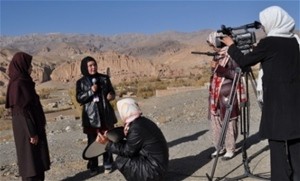
Through a grant from ASGP, women learn interviewing skills, broadcasting, media use, computer skills, and photography in a program designed by the Bamyan Journalists Association.
USAID/Creative Associates
Women are gaining skills in journalism and media, leading to employment and giving a voice to themselves and others
22 JANUARY 2011 | BAMYAN PROVINCE, AFGHANISTAN
Overlooking the breathtaking Buddhas of Bamyan Province in central Afghanistan, ten young women stand in a semi-circle around a camera and tripod, holding microphones and a light reflecting screen. With poise and charisma, they practice directing while they take turns interviewing each other, not only about their community, but also about why this program is so important for them. These women have never practiced with a real camera, yet they catch-on immediately and feel the thrill of directing and reporting.
The television station and two radio stations operating in Bamyan City do not employ any professional female media staff. Although they have expressed a desire for professional female journalists, there are no trained journalists available in the region. The Bamyan Journalists Association is changing that.
The association received a quick impact grant from the USAID-supported Ambassador’s Small Grants Program to educate young women interested in communications and journalism in the province. The association is using the grant to train 10 literate young girls on reporting, computer skills, interview techniques, TV broadcasting, and photography for four months. The goal of the program was to provide women with the skills and education needed to obtain employment within Bamyan Province or throughout Afghanistan. “Women need a voice and we are giving these women the skills to be a voice for themselves and for others,” said Hadi Ghafari, the head of the Association. The association provides a safe and constructive environment for the students. Women attend classes for two hours every day, and some stay longer. Already two students trained by the association have gone on to work as reporters for the BBC.
With its first grant, the association decided to start small, in order to gauge interest in the program. However, after the program idea was announced in the community, 240 interested women and girls wanted to participate. Now, the association plans to apply for an additional grant and is trying to find other resources to ensure they can reach the remaining 230 women interested in participating in this valuable initiative.







Comment
Make a general inquiry or suggest an improvement.